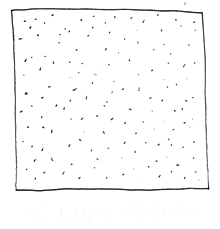
IMAGE ABOVE: Jaime Eizaguirre remixed by Jaime Eizaguirre
Experiment #3: complexity through randomness (I):
Accidental randomness: hand drawing is not always a precise tool, and we can see that by drawing the same simple element (a circle, for example) several times.

> Computer analysis: analysing subtle variations by superposing (fig. 3a) and animating (fig. 3b). These subtle variations can be seen as mistakes, unprecise geometries, but they also have their value: they can be perceived as more natural and organic. It’s also interesting to see how we work with codes: we all understand that what is represented is a matrix of circles of the same size even if they are not circles and they have different sizes.


Experiment #4: complexity through randomness (II).
Voluntary randomness: producing aleatory-looking images, like a dot texture. Something that could be quite complex to define mathematically can easily be done by analogical means.

> Computer analysis: how to produce something similar with a graphic editing program. Trying to create a brush from a scanned hand-drawn dot and introducing variables to create an aleatory-looking dot texture. How many parameters do we have to work with to get a result like the analogical one? When we draw random elements, do we really want them to be random or do we control this randomness?
HAND-DRAWING THE COMPLEXITY is a work by JAIME EIZAGUIRRE featured at COMPLEXITYS on FRIDAYS of JUNE
Hand-drawing is a main tool in my work as an architect and illustrator. I usually focus the analysis of this tool from the point of view of simplicity: the power of suggestion of iconic images or hand-drawing as a fast tool to communicate. So, when invited to contribute to this blog I had to ask myself about the relation between hand-drawing and complexity.
I proposed myself a series of short exercises/experiments around this question:
How can we generate complexity through hand-drawing?
Each one of these exercises tries to create complexity through a different concept: variation, combination, randomness…
After drawn and scanned, the exercises are re-worked / transformed in a simple way using a computer, trying to better understand the results of these experiments and the differences between working analogically or digitally. I will also try to extract some kind of conclusions of each of the exercises.
///////////////////
MORE ABOUT JAIME EIZAGUIRRE

